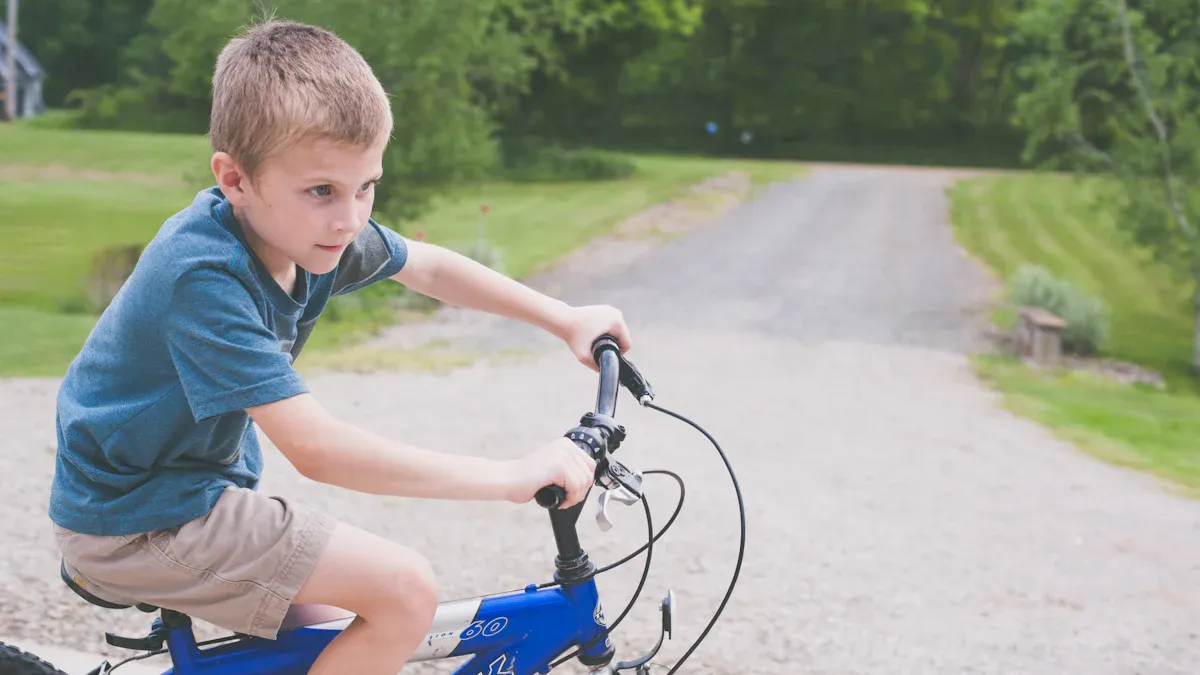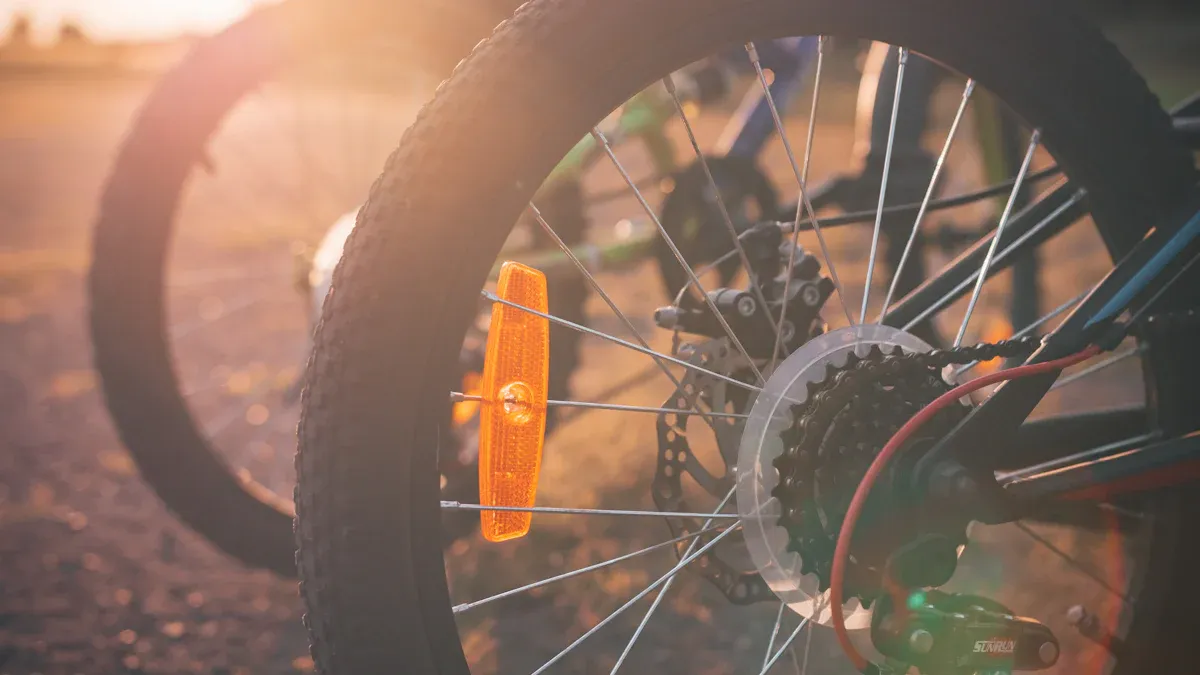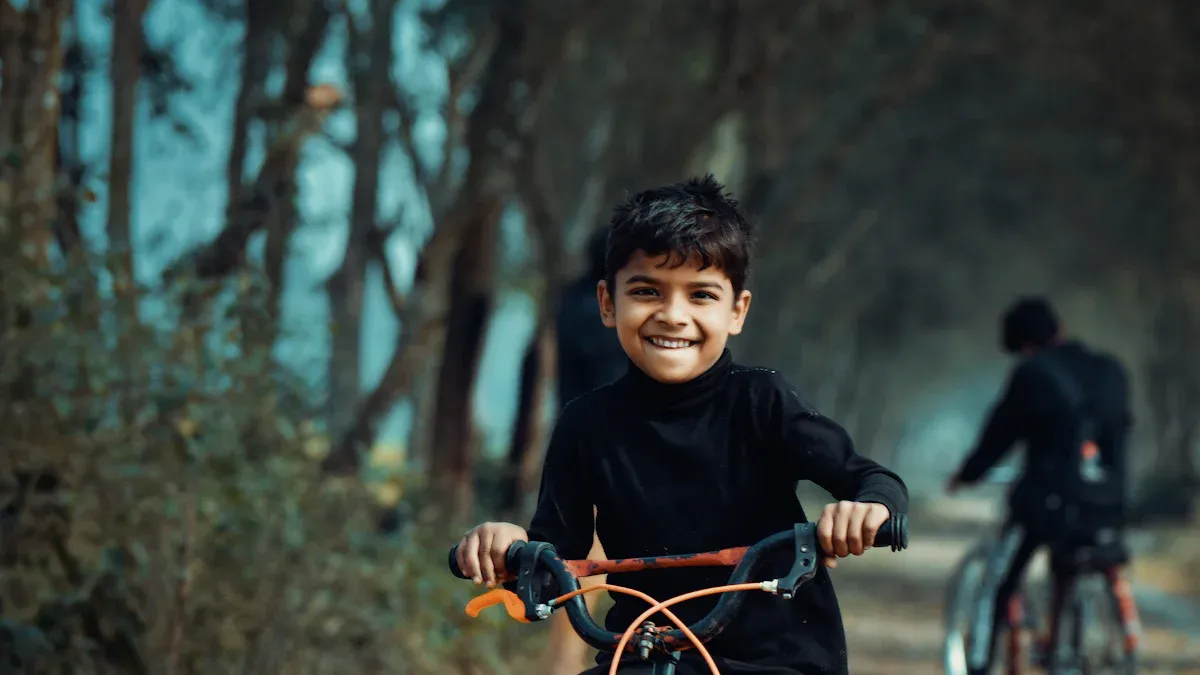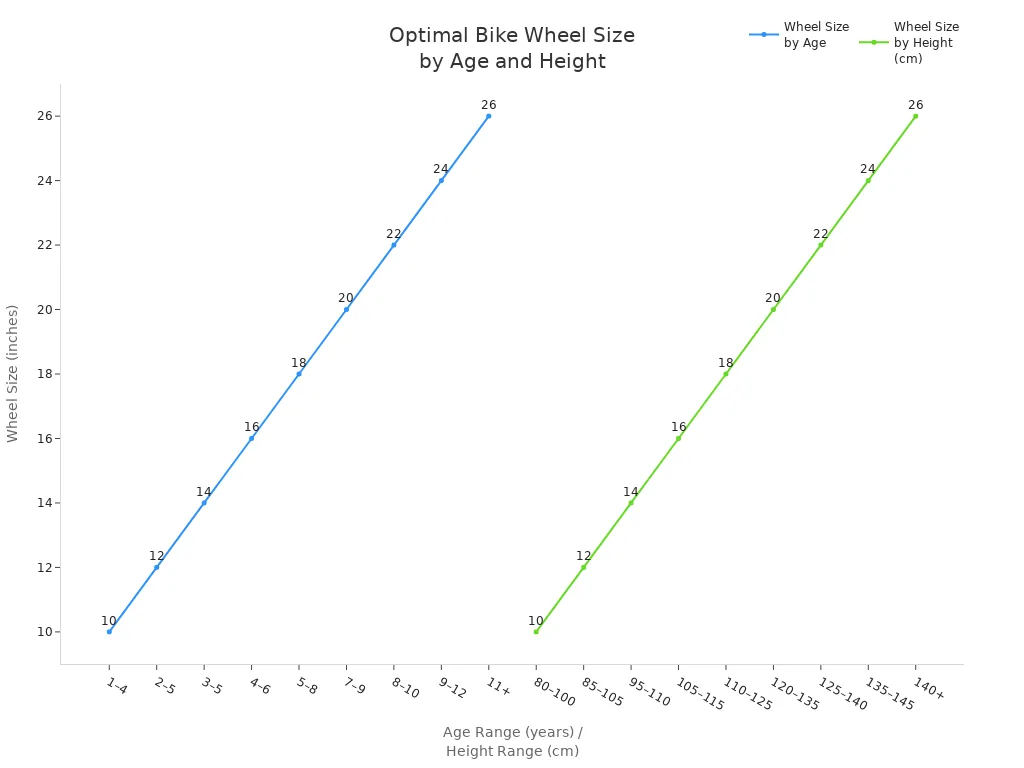
Choosing the right bike frame for your child is crucial. You want to ensure their safety and comfort while they ride. A well-selected kids carbon bike frame not only enhances their experience but also helps them develop essential riding skills. Investing in the right bikes for kids sets them up for fun and confidence on two wheels.
Key Takeaways
Select a light carbon bike frame. This helps your child control the bike easily. It also makes for a comfy ride with less shaking.
Choose the right bike size. Measure your child’s inseam and height. This ensures safety and a better riding experience.
Check for safety features. Look for good brakes, chain guards, and adjustable parts. These keep your child safe and comfy as they grow.
Understanding Kids Carbon Bike Frames

When you think about a kids carbon bike frame, imagine a light and strong structure made just for young riders. These frames use carbon fiber, which is strong and flexible. This helps your child have a smoother ride because carbon frames soak up bumps better than other materials.
Here are some important benefits of choosing a kids carbon bike frame:
Lightweight: Carbon frames are the lightest choice. This helps your child control the bike easily, especially when learning to ride or going over tough paths.
Comfort: Carbon absorbs vibrations well, giving a comfy ride. Your child will feel less tired on longer rides, so they can enjoy biking even more.
Performance: With a carbon frame, your child can go faster and be more agile. The light weight helps them speed up quickly, making it easier to keep up with friends.
To help you understand better, here’s a quick comparison of different bike frame materials:
Frame Material | Weight | Comfort (Vibration Absorption) | Durability | Cost | Notes |
|---|---|---|---|---|---|
Carbon | Lightest | Best (absorbs vibrations well) | Can crack, needs repair if damaged | Highest | Most comfortable and lightest, but more expensive and fragile |
Aluminum | Heavier than carbon | Less comfortable than carbon | Strong, can dent but usable | Moderate | Heavier and less vibration-absorbing, but more affordable and durable |
Steel | Heaviest | Comfortable due to strength | Very strong, may rust | Lowest | Heavy, strong, less good for speed |
As you can see, a kids carbon bike frame is special for being light and comfy, making it a great choice for young riders.
Kids’ Bike Sizes

What Size Bike Does My Child Need?
Choosing the right bike size for your child is essential for their safety and enjoyment. Kids’ bikes are typically sized based on the diameter of the wheels, which ranges from 12 to 26 inches. Here’s a quick overview of the recommended wheel sizes based on age:
Approximate Age | Recommended Wheel Diameter | Key Safety Notes |
|---|---|---|
2-4 years | 12 inches | Often with training wheels; suitable for beginners |
4-6 years | 14 inches | Commonly sold in toy and big box stores |
5-8 years | 16 inches | Usually rear coaster brakes; some have front hand brakes |
6-9 years | 18 inches | Not commonly available; transitional size |
7-10 years | 20 inches | Some models have multi-speed and hand brakes |
9+ years | 24 inches | Features similar to adult bikes; hand brakes common |
This table shows how the right bike size changes as your child grows. Remember, a bike that fits well allows your child to control it better, making their rides safer and more enjoyable.
Measuring for Proper Fit
To ensure your child has the ideal bike size, follow these steps for measuring:
Have your child straddle the bike with both feet flat on the ground.
Check if they can get onto the bike seat by slightly tipping the bike to one side.
Make sure their knees don’t hit the handlebars when they pedal.
Ensure their legs aren’t stretched out too far, which can make it hard to maneuver.
Use their inseam length to select the appropriate wheel diameter. Here’s a guideline based on age and inseam:
Wheel Diameter | Child’s Inseam Range | Approximate Age Range |
|---|---|---|
12 inch | 14-20 inches (35-50 cm) | 1-4 years old |
16 inch | 19-23 inches (48-58 cm) | 3-6 years old |
20 inch | 22-25 inches (55-63 cm) | 5-9 years old |
24 inch | 24-28 inches (60-72 cm) | 8-12 years old |
26 inch | 26-32 inches (60-72 cm) | 13+ years old |
Consider the type of brakes suitable for your child’s age. Younger kids often start with coaster brakes, while older kids can handle hand brakes.
Always check the bike’s overall condition, including the front wheel, frame strength, and chain guard, to ensure safety.
Don’t forget to have your child wear a properly fitting helmet when riding.
By following these steps, you can confidently choose the right bike size for your child. A well-fitted bike not only enhances their riding experience but also boosts their confidence as they learn and grow.
Key Considerations
When picking a kids carbon bike frame, think about some important things. These include weight, how easy it is to steer, and safety features. Each of these factors helps make sure your child has a safe and fun ride.
Weight and Maneuverability
Weight is very important for a kids’ bike. A lighter bike frame helps your child control the bike better. This is especially true for younger kids who are still learning to balance and coordinate.
Here’s a quick look at how weight affects different bike carrier types:
Bike Carrier Type | Child Weight Limit (lbs) | Age Range (years) | Stability / Wobble Notes | Safety Considerations / Impact on Handling |
|---|---|---|---|---|
Weehoo Trailer Cycle | 80 | 2 – 7 | Minimal wobble; wobble increases with kids over 60 lbs | Higher center of gravity affects balance; less stable than low trailers |
Bike Trailer (Single) | 40 – 48 | 1 – 5 | No wobble; very stable ride | Low to ground; easy to use; stable for inexperienced riders |
Bike Trailer (Double) | 80 – 97 | 1 – 5 | No wobble; very stable ride | Same as single trailer but higher capacity |
Baby Bike Seat | 33 | 1 – 3 | N/A | Child exposed in crash; compatibility issues; safety depends on bike fit |
MTB Child Bike Seat | 48 – 60 | 2 – 5 | No wobble; very stable ride | Weight centered on bike; no effect on adult balance |
Bike Tow Bar | Compatible with 12″-20″ bikes | 3 – 7 | Wobble varies by model; cheap models wobble more | Higher center of gravity affects balance; less stable ride |
As you can see, the bike’s weight affects how stable and easy it is for your child. A lighter bike frame helps them feel more confident and in control, especially when turning or riding on bumpy paths.
Safety Features to Look For
Safety should always come first when choosing a bike for your child. Here are some key safety features to think about:
Braking Systems: Younger kids often do better with coaster brakes, which are easier to use. Older kids might like hand brakes for better stopping.
Brake Lever Size: Make sure the brake levers fit your child’s hands. This helps them stop safely.
Visibility: Look for bikes with reflectors on the front, back, and wheels. This keeps your child visible to others, especially in low light.
Chain Guards: These stop clothes from getting caught in the chain, lowering the chance of accidents.
Proper Fit: A bike that fits well is very important for safety. Use height and inseam measurements to find the right size.
Adjustability: Features like adjustable handlebars and seat height help keep your child comfortable as they grow.
Test Rides: Always take the bike for a test ride. This helps you check its handling and safety features before buying.
By keeping these points in mind, you can choose a bike that fits your child’s needs and keeps them safe while riding.
Assessing Your Child’s Needs
Choosing the right bike for your child means considering their unique needs. Two key factors are their skill level and riding style.
Skill Level and Riding Style
Your child’s skill level plays a big role in selecting the right bike. If they’re just starting, a bike with a lower center of gravity can help them feel more stable. For kids who love BMX riding, a bike with 20-inch wheels offers quick handling and control. On the other hand, if your child enjoys cruising around the neighborhood, a bike with 26-inch wheels might be a better fit.
Here are some common riding styles and their frame implications:
BMX Riding: Quick turns and jumps; smaller wheels (20 inches) are ideal.
Casual Riding: Longer rides on smooth paths; larger wheels (26 inches) provide better speed and comfort.
Growth Considerations
Kids grow fast, and their bikes should keep up! Look for bikes with adjustable features like telescopic seat posts and handlebars that can change height. This adaptability allows the bike to grow with your child, extending its usability and ensuring comfort.
To help you choose the right size, consider this table that correlates height and age with wheel size:
Height (cm) | Height (inches) | Age (years) | Wheel Size (inches) |
|---|---|---|---|
80–100 | 2’7″–3’3″ | 1–4 | 10″ |
85–105 | 2’9″–3’5″ | 2–5 | 12″ |
95–110 | 3’1″–3’7″ | 3–5 | 14″ |
105–115 | 3’5″–3’9″ | 4–6 | 16″ |
110–125 | 3’7″–4’1″ | 5–8 | 18″ |
120–135 | 3’11″–4’5″ | 7–9 | 20″ |
125–140 | 4’1″–4’7″ | 8–10 | 22″ |
135–145 | 4’5″–4’9″ | 9–12 | 24″ |
140+ | 4’7″+ | 11+ | 26″ |
This table shows how height is the best indicator for bike size. Remember, a well-fitted bike boosts your child’s confidence and makes riding more enjoyable!

By considering your child’s skill level, riding style, and growth patterns, you can find a bike that fits them perfectly and keeps them riding safely for years to come.
Budgeting for a Quality Kids’ Bike
When you buy a kids’ bike, you want to get good value. A good bike can cost more, especially if it has a carbon frame. But don’t worry! You can find a good bike that is both affordable and strong.
Balancing Cost and Durability
Carbon bike frames usually cost more than aluminum ones. But the benefits can be worth it. Here are some things to think about:
Quality Construction: Brands like Giant and Specialized make strong, light frames. They use good parts, like Shimano, which help the bike last longer. Bikes from department stores may have heavier steel frames and cheaper parts that wear out faster.
Professional Assembly: When you buy from a bike shop, experts put the bike together and check it. This careful process makes sure everything is safe and works well. In contrast, bikes from department stores often get put together quickly, which can cause safety problems.
Ergonomic Design: Good brands design bikes for kids. They make bikes with easy-to-use brake levers and sizes that fit kids, making it easier for your child to ride safely and comfortably.
Durability Features: Look for bikes with protective parts, like derailleur cages, to prevent damage. High-quality bikes also use standard parts, which makes fixing them easier and helps them last longer.
After-Sales Support: Buying from a bike shop usually means you get help and warranties later. This can be very helpful if you need repairs or adjustments later on.
Value for Money
So, how can you make sure you’re getting good value? Here are some things to think about:
Long-Term Investment: A well-made carbon bike can last for years, even through several kids. This means you won’t need to buy a new one as often, saving you money over time.
Comfort and Performance: A lighter bike that absorbs bumps well will make riding more fun for your child. This can encourage them to ride more, helping them get better at it.
Resale Value: Good bikes usually keep their value better than cheaper ones. If you decide to sell or give it away, you might get a good return on your investment.
Popular Brands for Kids’ Bikes
When picking a kids carbon bike frame, choose brands that are well-known. Here are two popular brands that are great in the market:
Brand A: Trek
Trek is famous for making high-quality bikes, including those for kids. They have many models for different ages and riding styles. One great thing about Trek is their excellent warranty service. Many users say that Trek replaces bikes even after many years, as long as you keep the original receipt. This good customer service helps parents trust and stay loyal to the brand.
Brand B: Specialized
Specialized is another great choice for kids’ bikes. They focus on making the best child bicycle options with designs just for kids and light frames. Their models, like the Specialized S Works FSR, get good reviews for how well they perform and how comfortable they are. However, some people have pointed out issues with their warranty policies. They often do not help second-hand owners without receipts, which can make it hard for some families.
In the last three years, many exciting models have come out. For example, Lahyla Bicycles launched two new carbon full-suspension mountain bikes for kids. One is a 24″ model for ages 7 to 9, and the other has a mullet setup for ages 9 to 12. Other popular models include the Yeti ASR and Cannondale Scalpel, which young riders really like.
By looking at these brands, you can find a good bike that fits your child’s needs and gives them a great riding experience.
Choosing the right carbon bike frame for your child is essential. Remember to consider their size, skill level, and riding style. By making an informed decision, you’ll help them enjoy biking safely and comfortably. So, take your time, and find the perfect fit for your little rider! 🚴♂️✨
FAQ
What is the lifespan of a kids’ carbon bike frame?
A kids’ carbon bike frame can last several years with proper care, often outlasting cheaper materials.
How do I maintain a carbon bike frame?
Regularly check for cracks, clean it with mild soap, and avoid extreme temperatures to keep it in good shape.
Can my child ride a carbon bike on rough terrain?
Yes! Carbon bike frames are lightweight and absorb shocks well, making them suitable for rough trails and bumpy paths. 🚴♀️✨
See Also
Professional Tips For Selecting The Ideal Carbon Mountain Frame
A Guide To Picking The Perfect Bike Frame For You
Effective Advice On Finding Durable Cargo Bike Frames
